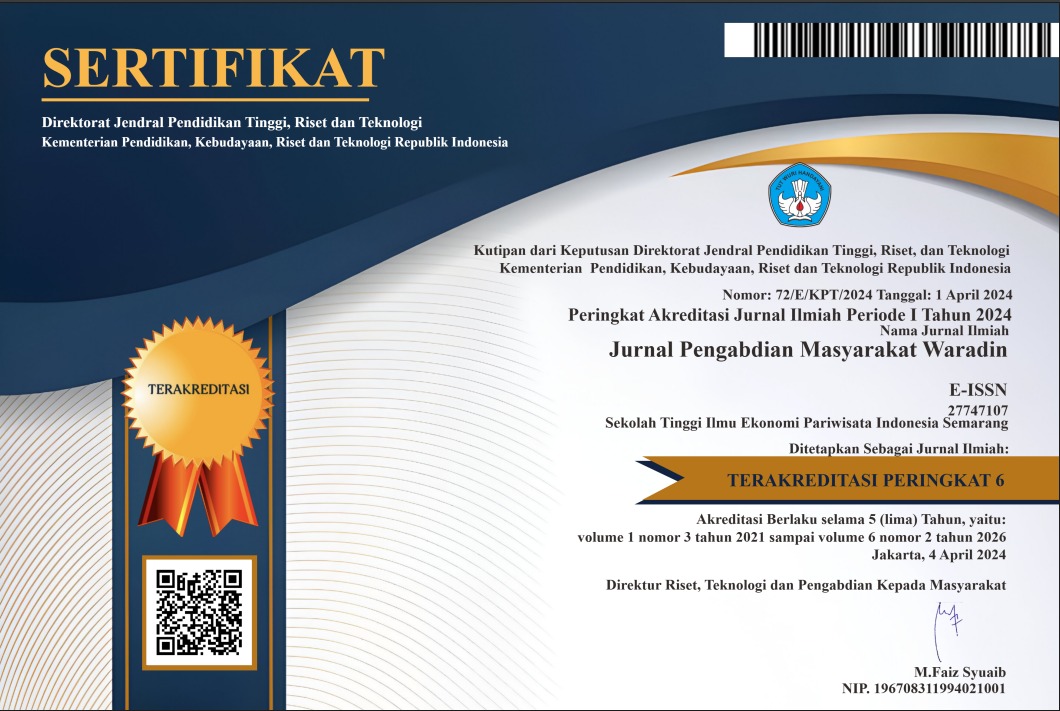Pengendalian Faktor Confounding Stroke
DOI:
https://doi.org/10.56910/wrd.v4i2.344Keywords:
Control, Stroke Factors, LBB Mabini ApartelleAbstract
Stroke is a functional disorder of the brain with varied clinical manifestations, which occurs suddenly due to disturbances in cerebral blood circulation. Stroke is a major cause of mortality and disability despite its increasing prevalence. Promotive and preventive efforts are still the main priority in efforts to reduce morbidity, disability and mortality. Early detection of someone who has risk factors is very necessary considering that stroke can attack anyone at any time. STIKES Kesdam IV/Diponegoro is a health university that has a vision of global competitiveness, so it really supports the Tri Dharma of Higher Education activities at the international level, including carrying out community service activities in the health sector in the Philippines. This community service activity is a promotional activity in the form of education about stroke and a preventive activity in the form of screening for stroke risk factors directly to the community. Screening is carried out for 3 stroke risk factors, namely blood pressure, cholesterol levels and blood sugar levels. The results of community service showed that after providing education using posters and leaflets, there was an increase in the knowledge of LBB Mabini Apartelle residents regarding definitions, modifiable risk factors, and stroke prevention. The health screening results of the 20 people examined showed that 40% had a risk of stroke from measuring blood pressure and 20% had a risk of stroke from measuring cholesterol.
References
AHA. (2021). 2021 heart disease & stroke statistical update fact sheet: Global burden of disease. https://doi.org/10.1161/CIR.0000000000000950
Alimansur, M., & Irawan, H. (2020). Personal hygiene mandi dalam pencegahan dekubitus pasien stroke. Jurnal Penelitian Sekolah Tinggi Ilmu Kesehatan Nahdlatul Ulama Tuban, 2(1), 14–17. https://doi.org/10.47710/jp.v2i1.31
Athiutama, A., & Trulianty, A. (2021). Karakteristik dan hubungannya dengan kualitas hidup pasien pasca stroke. Jurnal Ilmiah Kesehatan Jiwa, 3(1), 13–20. Retrieved from https://jurnal.rsamino.jatengprov.go.id/index.php/JIKJ/article/view/29
Budianto, P., Mirawati, D. K., Prabaningtyas, H. R., Putra, S. E., Muhammad, F., & Hafizhan, M. (2021). Stroke iskemik akut dasar dan klinis (P. Budianto, Ed.). Surakarta.
Ferawati, S., Ika, R., Salma, A., & Yayuk, I. (2020). Stroke: Bukan akhir segalanya (Cegah dan atasi sejak dini) (Ferawati, Ed.). Guepedia.
John Hay. (2023). Philippines, August 17-19, 2023 at CAP John Hay. https://www.strokesocietyphilippines.org/
Padmanabhan, K. N., et al. (2021). Comparison of Siriraj Stroke Score with computed tomography to differentiate acute embolic and hemorrhagic stroke in a tertiary care-teaching center. Eurasian Journal of Emergency Medicine, 62-67.
Setiawan, P. A. (2021). Diagnosa dan tatalaksana hemoragik. Jurnal Medika Hutama, 1660-1665.
Sutarwi, Bakhtiar, Y., & Rochana, N. (2020). Sensitivitas dan spesifitas skor stroke: Literature review. Gaster, 18, 186-193.
Yunani, O., Jolang, J., & Winarto, E. (2022). Siriraj Stroke Score to detect cerebrovascular disease: Hemorrhagic vs non-hemorrhagic. Jurnal Ilmiah Indonesia, 1-7.







